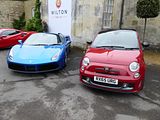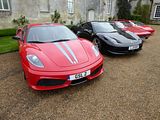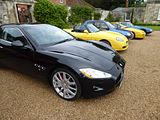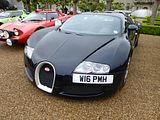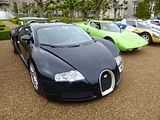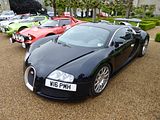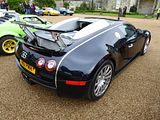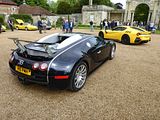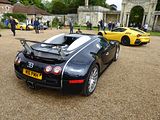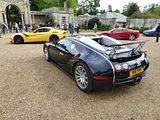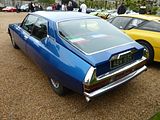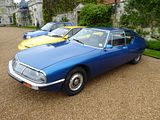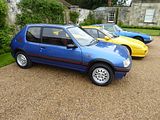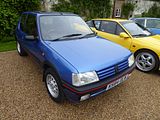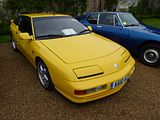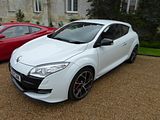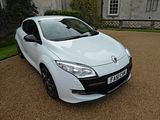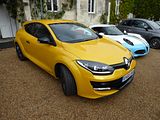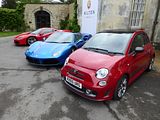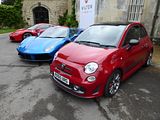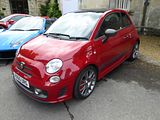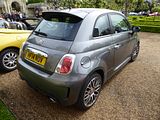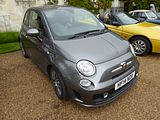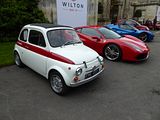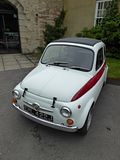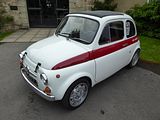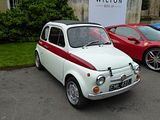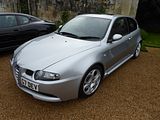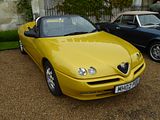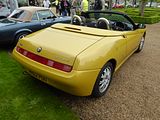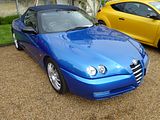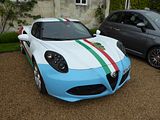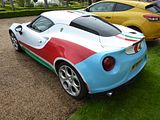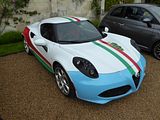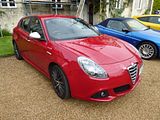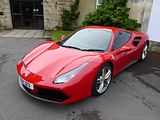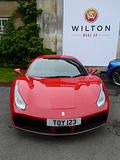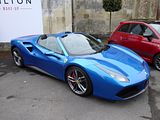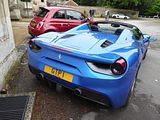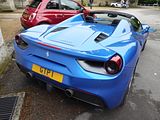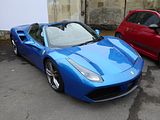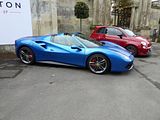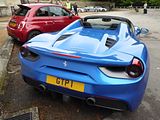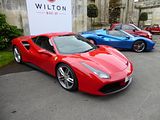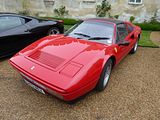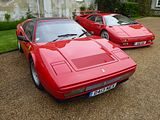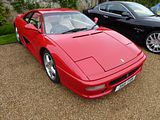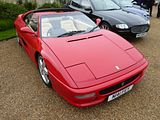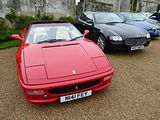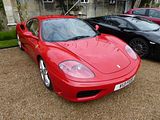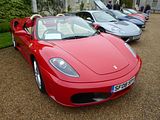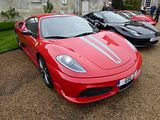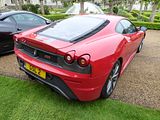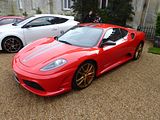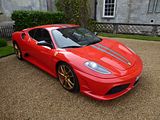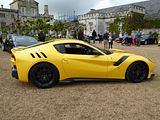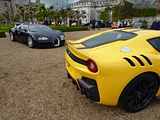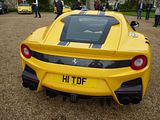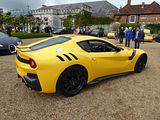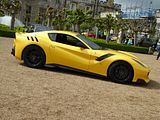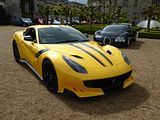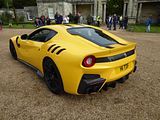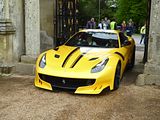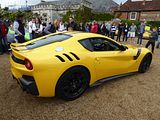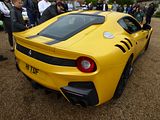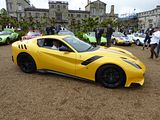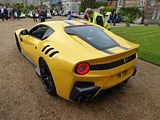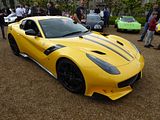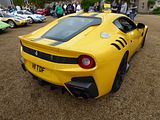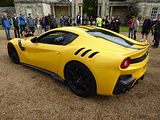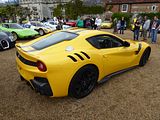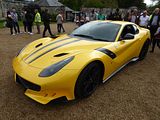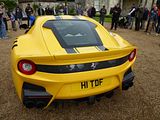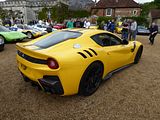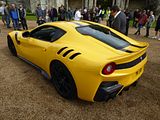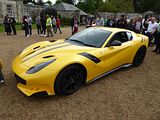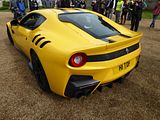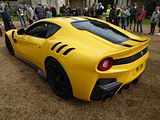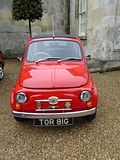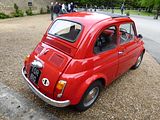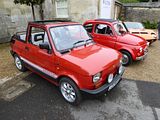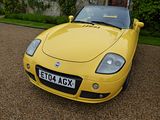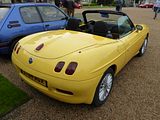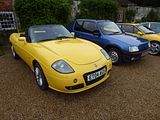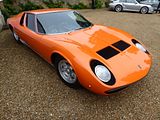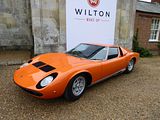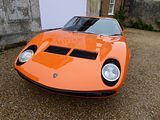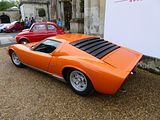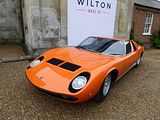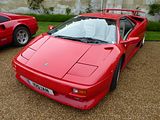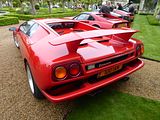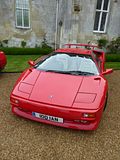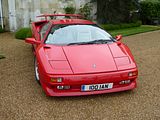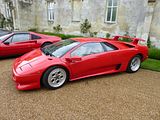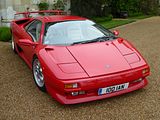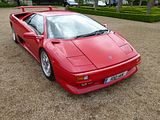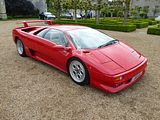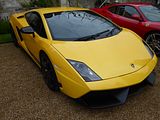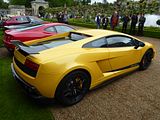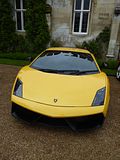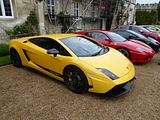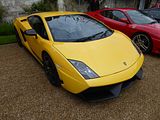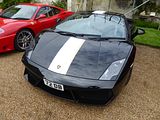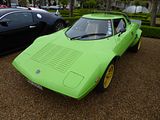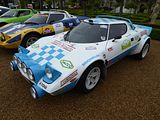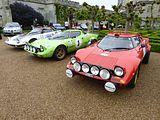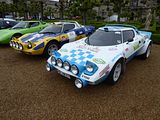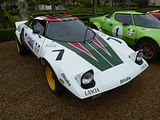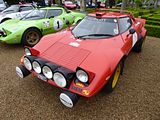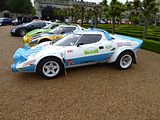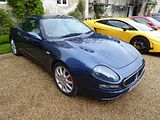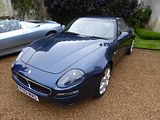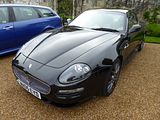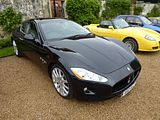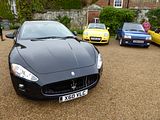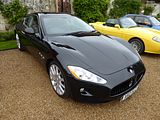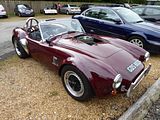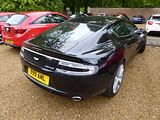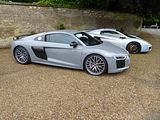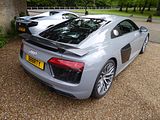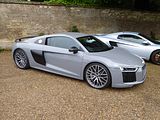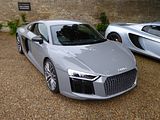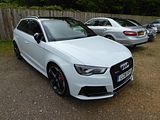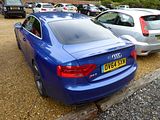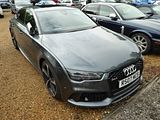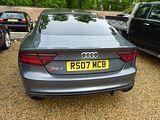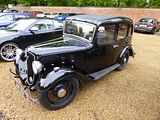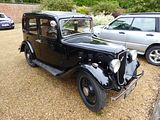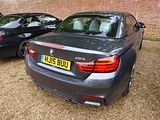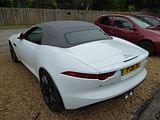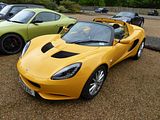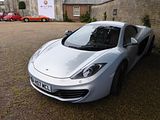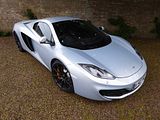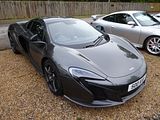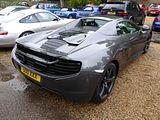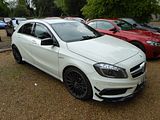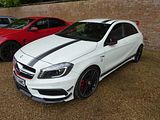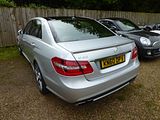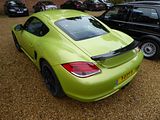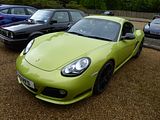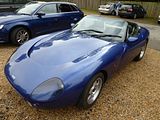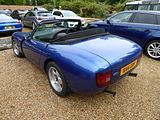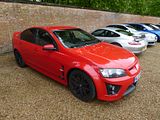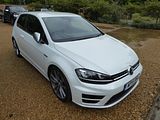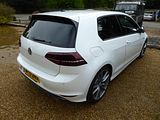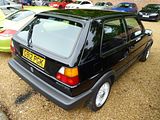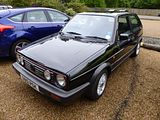For the last few years, I have been making an annual journey to Wilton House, situated in Wilton, a small town just to the north west of Salisbury, and home of Lord Pembroke, once a year for a Supercar event. In 2015, the format grew to encompass Classics as well and the event extended to cover a second day. It was an excellent event, made even more special by the surroundings. I was looking forward to the 2016 version, when out of the blue, an email arrived around the turn of the year advising that the organisers had some ambitious plans for how to develop it still further, but these were such that it would not be possible to hold the event at all in 2016. So, no trip to Wilton this year, until, that is, I remembered that this yet another location for a series of Breakfast Clubs during the summer months. Held on Sunday mornings from April to September, each with a theme, these free to attend events go by the title of “Wilton Wake Up”. They were launched in 2014, and proved instantly popular, as, it would seem, do all such morning gatherings. Wilton is further from home than most of the other UK Breakfast Clubs that I’ve attended, but when I got an email with details of the May 2016 meeting, and its theme was “Franco-Italian Furore”, and my diary was otherwise clear for the day, it proved irresistible, even though it did entail a relatively early start. Well, not that early, as although the event gets underway from 8am, finishing at 11am, cars can and do arrive whenever they want all morning. The alarm clock was duly set and I headed off on a rather grey morning to see what this Wilton Wake Up had in store.
FRENCH CARS
The theme was stated as “Franco-Italian Furore”, so I was hopeful that there were would be plenty of interesting French cars on the other side of the main gate. Whilst what was there hit the “interesting” attribute, the word “plenty” was way short of the mark. There were precisely four French cars when I arrived, and only a couple more arrived during the morning.
BUGATTI
What better car to start off with than one belonging to His Lordship? A keen collector of cars, with an extensive array of models that he owns on display in a coachhouse annexed to the main house, the Veyron is perhaps the best known of all his cars, and a model which needs little introduction in and of itself. This car had a very distinctive wrap for a couple of years, but that was subsequently removed, to reveal the very dark blue paintwork. His Lordship has used his car plenty, covering well over 20,000 miles in it, which is “high mileage” for Veyron. Needless to say, it proved quite an attraction, parked in the centre of the courtyard.
CITROEN
The sole Citroen here was an SM, that glorious Sports/GT Coupe that still wows everyone today with its elegant styling and advanced features. The Citroën SM was first shown at the 1970 Geneva Motor Show, but work on the car had started way back in 1961, with ‘Project S’, which was envisaged to be a a sports variant of the revolutionary Citroen DS. For the next few years, many running concept vehicles were developed, and these became increasingly complex and upmarket from the DS. In 1968, Citroën purchased Maserati, with the intention of harnessing Maserati’s high-performance engine technology to produce a true Gran Turismo car, which would combine Citroen’s advanced suspension with a V6 Maserati engine. The car was a sensation when revealed, with its distinctive styling, an amazingly low drag coefficient of just 0.26, and as well as the advanced features from the DS such as lights that swivelled with the steering and the advanced hydropneumatic self-levelling suspension there were numerous technical innovations such as variable assistance for the power steering, rain sensitive wipers and the option of lightweight wheels of composite alloys. It was a further six months before customers could get behind the wheel, with the SM finally going on sale in France in September of that year. The origin of the model name ‘SM’ is not clear. The ‘S’ may derive from the Project ‘S’ designation, and the ‘M’ may refers to Maserati, hence SM is often assumed to stand for ‘Sports Maserati’. Another common hypothesis is that SM stood for Série Maserati and others have suggested it is short for ‘Sa Majesté’ (Her Majesty in French), which would aligns with the explanation that the DS model was so called as a contraction of the French word ‘Déesse’ (The Goddess). Regardless of the origins of the name, it attracted lots of attention, and came third in the 1971 Car of the Year competition (behind Citroen’s own revolutionary GS model). For a couple of years, sales were reasonable, but they fell off dramatically in 1973, not just because of the Oil Crisis that struck late that year, but largely because the SM’s technical complexity came with a price tag of some terrible reliability problems, something which owners of rival cars simply did not experience. To compound the owner’s misery, they needed to find and pay for Citroen specialists who understood the hydraulics and a Maserati specialist for the engine. Both categories were kept busy. Citroen declared bankruptcy in 1974 and the company was purchased in May 1975. Thanks to changes in US legislation, sales in that market, which had hitherto been the SM’s largest had ceased, and so with global sales of under 300 SMs in 1974, having divested itself of Maserati, new owner Peugeot took the obvious decision to cease production of the SM almost immediately. During the SM’s 5 year product life, a total of 12,920 cars were produced. With the exception of a handful of conversions for the Australian market, all SMs were made in left hand drive, which is perhaps one reason why UK sales amounted to just 325 cars from that total. Although this is often labelled as one of the 4 “nightmare cars of the apocalypse” (along with the Triumph Stag and Alfa Montreal), the reality is that the surviving cars have largely been “fixed” and they are now not the fearsome ownership proposition that many still assume.
PEUGEOT
There was just one Peugeot, too, a late model 205 GTi. Peugeot launched their new “supermini”, the 205 in January 1983, just one day after Fiat had presented the Uno, one of the car’s principal rivals. It was an immediate hit, with smart styling and a range of engines which combined with sharp handling made it good to drive. Mindful of the success of the Golf GTi, in the class above, and how a small car with good handling could take more power, as the Mini Cooper had proved, Peugeot came up with the GTi in early 1984. The first models had a 1.6 litre XU5J engine, producing 105 PS, which was uprated in 1987 with a cylinder head with larger valves thus becoming XU5JA, which took the power output up to 115 bhp. Visually the car retained the good looks of the 3 door version of the regular models, but it featured plastic wheel arch extensions and trim, beefier front and rear bumper valances and judicious use of red badging and trim. The shell also underwent some minor changes, including larger wheel arches (to suit the larger wheels , and the suspension was redesigned and sat lower on the GTI with stiffer springs, different wishbones and a drop-linked anti-roll bar. Red was a dominant colour inside. The car was an instant hit. At the end of 1986, Peugeot followed up with a more potent model, the 1.9 GTi, whose XU9JA engine produced 128 PS. Internally the engine of this car and the 1.6 model are very similar, the main differences on 1.9 litre versions being the longer stroke, oil cooler, and some parts of the fuel injection system. The shorter stroke 1.6 litre engine is famed for being revvy and eager, while the 1.9 litre feels lazier and torquier. Outside the engine bay the main differences between the 1.6 GTi and the 1.9 GTi are half-leather seats on the 1.9 GTi vs. cloth seats and disc brakes all-round (1.9 GTi) vs. discs at the front and drum brakes at the back; as well as the 14-inch Speedline SL201 wheels on the 1.6 GTi vs. 15 inch Speedline SL299 alloys on the 1.9 GTi. The 205 is still often treated as a benchmark in group car tests of the newest GTI models or equivalent. Peugeot itself has never truly recreated this success in future GTI models, although they came very close with the highly regarded GTI-6 variant of the Peugeot 306. A cabriolet version of the 205, known as the CJ (or CT in France), was designed and partially assembled by Pininfarina of Italy. A CTi version, with the same plastic arches and wheels as the 1.6 GTI was also available. Only minor changes were made to the car in the next few years, with the most obvious visual change being the switch to grey bumpers and trim from black ones in 1990, along with revised lights. A new dashboard had been incorporated across the entire 205 range a couple of years before this. Sales of the GTI in the UK in the early 1990s were badly hit by soaring insurance premiums, brought about by high theft and ‘joy-riding’ of cars of this sort. Increasingly stringent emissions regulations meant the 1.6 GTi went out of production in 1992, while the 1.9 litre was sold for a couple more years thanks to re-engineering of the engine to enable it to work properly with a catalytic converter, which dropped power to 122 bhp. Many of them had a hard life, but there are some nice original cars out there and people are starting to spend serious money in restoring them.
RENAULT
Third of the line of French cars that was parked up before my arrival was this Renault-Alpine A610. Launched in 1991, as a successor to the GTA, it looked very like its predecessor, even though just about everything about the car was altered. There was a limited budget at the beginning of the development project so its appearance does not differ much from the GTA, and it looks particularly similar to the USA market GTA with its pop-up headlights (this was believed to be because the Alpine, when viewed head-on, strongly resembled mid-80s versions of the Ford Sierra; but the actual reason for that and for the batteries to be in the front was to better balance the weight between the front and the back). Nonetheless it was a completely different car, sharing only the windows with the GTA. The basic concepts of all Alpine cars are there, with the rear engine, and the steel backbone chassis that all Alpines since the A110 had had. The car was solely branded as an Alpine, as linking Alpine and Renault together (first as Alpine-Renault then Renault-Alpine) seemed to detract from the Alpine brand’s sporty image. The PRV engine remained, but it was enlarged to 3 litres, which enabled it to produce 250 PS (247 hp) and 260 lb/ft of torque. The A610 Albertville 92 was presented in 1991 for the Olympic Games. 2 examples, and other Renault cars, were used to drive VIPs, before being sold as occasion. They had a specific colour (Gardenia White) and interior, but used the same engine and had the same technical specifications. The A610 Magny-Cours was created for the Williams-Renault Formula One victory in the French Grand Prix at Magny-Cours in July 1991. 31 cars were built, with specific colour and interior. The A610 did not result in an improvement in sales over the commercially disappointing GTA and the car was discontinued in 1995, despite acclaim from the motoring press, and approval from Top Gear. The A610 was to be the last car so far to carry the Alpine name; after production of the A610 ended, the Alpine factory in Dieppe produced the Renault Spider.
During the morning a couple of more recent Renault models arrived, both of them the RenaultSport versions of the third generation Megane. Sold since 2010, there have been a multiplicity of different versions of this model, starting with a 250 bhp car which had a 2.0 litre twin-scroll turbo 4-cylinder F4Rt engine rated at 250 PS and 250 lb/ft of torque with a 6-speed manual gearbox, Brembo front brakes, front splitter, extended sills and wheel arches, rear diffuser with central exhaust pipe, and 18-inch alloy wheels wearing 225/40R18 tyres. Aluminium pedals, a Renault Sport steering wheel with thumb grips, analog rev counter and sport seats with extra lateral support dress up the cabin. Other features include front LED daytime running lights and bi-xenon headlights. A Cup version with a lightened chassis was offered from the start. In 2011, Renault introduced the Trophy which had 265bhp, and this engine was later made standard in the regular RS car as well. A couple of years later, a further 10 bhp was found, as Renault worked to regain their crown from SEAT for the fastest lap in a front wheel drive car at the Nurburgring, with the RS275 Trophy R car. This model had a raft of changes, starting with a little more power courtesy of the Akrapovič titanium exhaust bringing power up to 275 PS (271 bhp) while torque was unchanged at 360Nm. Öhlins dampers, 19″ Speedline Turini wheels and Michelin Pilot Cup 2 tyres replace the KYB dampers, 19″ Steev wheels and Bridgestone Potenza RE050A/Continental ContiSportContact 5P tyres used to date. The front brakes were changed to a 350mm rotor (up 10mm) while using the same calipers & rear brakes. Interior changes saw the deletion of the air conditioning, stereo and back seat while the Recaro Sportser CS seats are exchanged for Recaro fixed polycarbonate buckets trimmed with leather and alcantara. The total weight saving of all the changes amounted to a 101 kg loss, bringing kerb weight down to 1280 kg, 7.5 l/100 km and 174 g/km of CO2/km. The Mégane R.S. 275 Trophy also beat the records of several others circuits, proved by the videos Suzuka circuit with Laurent Hurgon, Fuji International Speedway with Laurent Hurgon, Tsukuba circuit with Kazuo Shimizu.
ITALIAN CARS
Perhaps not unexpectedly, the French cars were completely dominated by the Italians at this event, with representatives not just from every current Italian brand, but several cars from each. There was nothing particularly old among them, but these were all nice cars which anyone would be pleased and proud to own, and each generated lots of interest.
ABARTH
When I arrived in my 595 Competizione, behind a long line of Stratos models which are presented further down this report, rather than being waved through the main gate, the marshalls asked me to take up a position right alongside the gate as a sort of “welcoming car”, to go with a classic Fiat 500 which was parked on the other side of the gateway. Accordingly, there was no way that anyone was going to miss seeing my little machine, and sure enough, every time I went by it, there was usually some peering in. 500-based Abarth models have been on sale in the UK since the spring of 2009, and even though there are now a few thousand on UK roads, they are still relatively unknown and can surprise people. That certainly happened when I got in mine, ready to depart and fired it up, with the couple had just been admiring almost jumping out of their proverbial skin with surprise at the noise that came from the car. I was also rather chuffed when one of the young spotters who had been very busy with his camera and also video-ing some of the more interesting and exotic cars as they left ran after mine, to record the noise it made as I headed up the road.
A second 595 Competizione, a slightly earlier model from 2014 and hence a 160bhp one, arrived during the morning. I did not recognise the plate, and never saw the owner with the car, so still am unsure to whom it belonged.
Also parked out at the front, on the same side of the gate as me was this rather older “classic” 595 dating from 1971. This particular car is a regular at all sorts of Italian car shows and a reprint of the article that was written about this particular car for Classic and Sportscar magazine was proudly displayed in its side window, as ever.
ALFA ROMEO
Early arrivals were a couple of GTA models. Smaller of the pair was a 147 GTA. Replacing the 145 and 146 hatch models, the 147 made its debut in 2000 and impressed everyone with its class-leading looks and personality that ensured it claimed the Car of the Year award a few weeks later. Top of the range for some time was a 2 litre Twin Spark petrol model which went well enough, but lacked the real excitement that many were hoping for. Alfa addressed that, eventually, with the GTA model which they launched in 2002. Fitted with a 3.2 V6 engine which produced 247 bhp, it was the most powerful hot hatch available at the time, and the modifications to the body, including lower sills and wider wheel arches, if anything, made it look even better rather than endowing it with the sort of “after market look” that can afflict some high end performance versions of regular family cars. Performance figures were impressive, with the car able to achieve a top speed of 153 mph. It had a widened body by 15 mm at each side to accommodate the 225/45R17 tyres. Most models had a 6-speed manual transmissions; whilst a smaller number of other models used the semi automatic Selespeed system. Production ran through to 2004 and in total 5,029 147 GTAs were built, 1004 of which were Selespeeds. Only around 300 came to the UK, so this was never a common sighting on British roads.
Second GTA was a 156 GTA in Sportwagon guise. The 156 GTA cars were launched at the Frankfurt Motor Show in September 2001. Named after the Alfa Romeo GTA from the 1960s, the letters GTA meaning Gran Turismo Alleggerita (English: lightened Grand Tourer). 2,973 berlinas and 1,678 Sportwagons were built until the GTA production stopped in October 2005 as the 156 gave way to the Alfa Romeo 159. The GTA came with the 3.2 litre Bussone V6 engine (The big Busso, so called after legendary Ferrari engineer Giuseppe Busso), the largest capacity version of the much loved V6 engine. With a 93 mm bore and a 78 mm stroke giving it a capacity of 3,179 cc, it generated 250 PS (247 hp) and 300 N·m (220 lb/ft) of torque. After market Alfa Romeo specialist Autodelta produced performance versions up to 3.7 litres and 400 PS. The European Touring Car Championship winning 156 GTA was however running a 2.0 litre 4-cylinder 300 PS engine due to class regulations. The GTA variants were equipped with either a six-speed manual transmission or six-speed Selespeed (paddles in steering wheel, hydraulically operated robotised) gearbox, had a lowered and stiffened suspension, a distinctive body kit, wider rear arches and leather interior. The suspension was specifically made for the GTA by Fiat Research Centre and Fiat Auto Design and Development Department. Steering was also made faster, only 1.7 turns from lock to lock compared to 2.1 in normal models. The GTA had also larger brakes (Brembo), with 12″ front discs and 10.8″ at the rear. The front discs were later upgraded to 13 ” to cope with the performance potential. Even though the name suggests a light car, the GTA isn’t any lighter than other 156s, as it was actually 91 kilograms (201 lb) heavier than the 2.5 litre V6 engined version. The GTA did not get the Giugiaro designed facelift introduced to the 156 in 2002, but continued with the acclaimed Walter de Silva design to the very end of production.
By mid morning there were three examples of the 916 Series Spider here, showing the progression of the model, as there was one each of the Phase 1, 2 and 3 models on show. Alfa had been producing the open topped 105 Series Spider since 1966 and by the 1990s were long overdue a replacement. They decided to combine the follow on to the Alfetta GTV, long out of production, with a new Spider model, with first work starting in the late 1980s. The task was handed to Pininfarina, and Enrico Fumia’s initial renderings were produced in September 1987, with the first clay models to complete 1:1 scale model made in July 1988. Fumia produced something rather special. Clearly an Italian design, with the Alfa Romeo grille with dual round headlights, recalling the Audi-based Pininfarina Quartz, another design produced by Enrico Fumia back in 1981, the proposal was for a car that was low-slung, wedge-shaped with a low nose and high kicked up tail. The back of the car is “cut-off” with a “Kamm tail” giving improved aerodynamics. The Spider would share these traits with the GTV except that the rear is rounded, and would feature a folding soft-top with five hoop frame, which would completely disappear from sight under a flush fitting cover. An electric folding mechanism would be fitted as an option. Details included a one-piece rear lamp/foglamp/indicator strip across the rear of the body, the minor instruments in the centre console angled towards the driver. The exterior design was finished in July 1988. After Vittorio Ghidella, Fiat’s CEO, accepted the design, Alfa Romeo Centro Stile under Walter de Silva was made responsible for the completion of the detail work and also for the design of the interiors, as Pininfarina’s proposal was not accepted. The Spider and GTV were to be based on the then-current Fiat Group platform, called Tipo Due, in this case a heavily modified version with an all new multilink rear suspension. The front suspension and drivetrain was based on the 1992 Alfa Romeo 155 saloon. Chief engineer at that time was Bruno Cena. Drag coefficient was 0.33 for the GTV and 0.38 for the Spider. Production began in late 1993 with four cars, all 3.0 V6 Spiders, assembled at the Alfa Romeo Arese Plant in Milan. In early 1994 the first GTV was produced, with 2.0 Twin Spark engine. The first premiere was then held at the Paris Motor Show in 1994. The GTV and Spider were officially launched at the Geneva Motor Show in March 1995 and sales began the same year. The cars were well received. At launch, many journalists commented that Alfa had improved overall build quality considerably and that it came very close to equalling its German rivals. I can vouch for that, as I owned an early GTV for eighteen months, and it was a well built and reliable car. In 1997 a new engine, a 24-valve 3.0 litre V6, was available for the GTV along with bigger, 12.0 inch brakes and red four-pot calipers from Brembo. The console knobs were changed from round central to rectangle ones and to a three-spoke steering wheel. Some versions were upgraded with different front bumper mesh to bring the wind noise down to 74 dBA. In May 1998 the cars were revamped for the first time, creating the Phase 2 models. Most of the alterations were inside. The interior was changed with new centre console, painted letters on skirt seals, changed controls and switches arrangement and different instrument cluster. Outside, the main changes included chrome frame around the grille and colour-coded side skirts and bumpers. A new engine was introduced, the 142 hp 1.8 Twin Spark, and others were changed: the 2.0 Twin Spark was updated with a modular intake manifold with different length intakes and a different plastic cover. Power output of the 2.0 TS was raised to 153 hp. Engines changed engine management units and have a nomenclature of CF2. The dashboard was available in two new colours in addition to the standard black: Red Style and Blue Style, and with it new colour-coded upholstery and carpets. The 3.0 24V got a six-speed manual gearbox as standard and the 2.0 V6 TB engine was now also available for the Spider. August 2000 saw the revamp of engines to comply with new emission regulations, Euro3. The new engines were slightly detuned, and have a new identification code: CF3. 3.0 V6 12V was discontinued for the Spider and replaced with 24V Euro3 version from the GTV. 2.0 V6 Turbo and 1.8 T.Spark were discontinued as they did not comply with Euro3 emissions. By the 2001-2002 model year, only 2 engines were left, the 2.0 Twin.Spark and 3.0 V6 24V, until the Phase 3 engine range arrived. The Arese plant, where the cars had been built, was closing and, in October 2000, the production of GTV/Spider was transferred to Pininfarina Plant in San Giorgio Canavese in Turin. In 2003 there was another and final revamp, creating the Phase 3, also designed in Pininfarina but not by Enrico Fumia. The main changes were focused on the front with new 147-style grille and different front bumpers with offset numberplate holder. Change to the interior was minimal with different centre console and upholstery pattern and colours available. Instrument illumination colour was changed from green to red. Main specification change is an ASR traction control, not available for 2.0 TS Base model. New engines were introduced: 163 hp 2.0 JTS with direct petrol injection and 237 hp 3.2 V6 24V allowing a 158 mph top speed. Production ceased in late 2004, though some cars were still available for purchase till 2006. A total of 80,747 cars were made, and sales of the GTV and Spider were roughly equal. More V6 engined GTVs than Spiders were made, but in 2.0 guise, it was the other way round with the open model proving marginally more popular.
This very distinctively liveried 4C Competizione has been seen at a number of events in the UK in the past 18 months. The Alfa 4C Competizione and Spider have been available for a couple of years now, but they are still a rare sight, which was always going to be the case with very limited production volumes, and relatively high prices making sure of that.
Also from the current range was an example of the Giulietta hatch. On sale for nearly 6 years now, incredible though that might seem, the Giulietta makes regular appearances at Italian car events, clearly accepted as the next generation of classic Alfa from the superceded models, and that only seems right and proper when you consider that it is one of the most stylish cars in its class, with a range of engines which combine very competitive emissions with the sort of sparkling performance that is expected of an Alfa Romeo.
FERRARI
There were more Ferrari models here than any other marque, which is perhaps not a surprise, as what could sum “Italian Furore” better than one of these legends. Two of the latest models were arranged on one side of the main gate. These were a 488 GTB and the more recent 488 Spider. Launched at the 2015 Geneva Show, the 488GTB followed the lead set by the California T in bringing turbocharging into a modern-day, mid-engined V8 Ferrari supercar for the first time. The engine is completely new when compared with its V8 stablemate, not only in components but also in feel and character. It is a twin-turbocharged 3902cc unit whilst that in the California T is 3855cc. In the 488 GTB, it produces 660bhp at 8000rpm and 560lb ft at 3000rpm. Both outputs are significant increases over the normally aspirated 4.5-litre V8 used in the 562 bhp 458 Italia and 597 bhp 458 Speciale, and also greater than the car’s biggest rival, the McLaren 650S. The torque figure of the 488 GTB is such that it also exceeds the 509lb ft at 6000rpm of the normally aspirated V12 used in the range-topping Ferrari F12 Berlinetta. The mighty new engine in the 488 GTB drives the rear wheels through a revised seven-speed dual-clutch automatic gearbox derived from the 458. It features a new ‘Variable Torque Management’ system which, Ferrari says, “unleashes the engine’s massive torque smoothly and powerfully right across the rev range”. The gear ratios are also tuned to “deliver incredibly progressive acceleration when the driver floors the throttle”. The 488 GTB can crack 0-62mph in just 3.0sec, 0-124mph in 8.4sec and reach a top speed of 205mph. Its 0-62mph and 0-124mph times match the McLaren 650S’s, but the Woking car’s top speed is slightly higher at 207mph. The engine also accounts for the ‘488’ element of the car’s name, because each of the engine’s eight cylinders is 488cc in capacity when rounded up. The GTB suffix, standing for Gran Turismo Berlinetta, is a hallmark of previous mid-engined V8 Ferraris such as the 308 GTB. Not only is the new turbo engine more potent than the 4.5-litre V8 from the 458 Italia, but it is also more economical. Combined fuel economy is rated at 24.8mpg, compared with 21.2mpg in the 458 Italia, and CO2 emissions are 260g/km – a 47g/km improvement. Ferrari’s HELE engine stop-start system features on the 488 GTB. Developments on the dynamic side include a second generation of the Side Slip Angle Control system, called SSC2. This allows the driver to oversteer without intruding, unless it detects a loss of control. The SSC2 now controls the active dampers, in addition to the F1-Trac traction control system and E-Diff electronic differential. Ferrari says the result is “more precise and less invasive, providing greater longitudinal acceleration out of corners” and flatter, more stable behaviour during “complex manoeuvres”. Learnings from the Ferrari XX programme have also been incorporated into the 488 GTB, something that Ferrari says allows all drivers and not just professionals, to make the most of its electronic and vehicle control systems. It also claims the 488 GTB is “the most responsive production model there is”, with responses comparable to a track car. The 488 GTB has lapped Ferrari’s Fiorano test track in 1min 23sec – two seconds faster than the 458 Italia, and half a second quicker than the 458 Speciale. The dimensions of the 488 GTB – it is 4568mm in length, 1952mm in width and 1213mm in height – closely match the 458 Italia from which it has evolved. Its dry weight is 1370kg when equipped with lightweight options – 40kg more than the McLaren 650S. The new look, styled at the Ferrari Styling Centre, features several new aerodynamic features that improve downforce and reduce drag. Most notable is the addition of active aerodynamics at the rear through a ‘blown’ rear spoiler, where air is channelled from the base of the glass engine cover under the spoiler. This contributes to the 50% increase in downforce over the 458 Italia. Also new is a double front spoiler, an aerodynamic underbody, a large air intake at the front that references the 308 GTB, a diffuser with active flaps, new positioning for the exhaust flaps and new-look lights. The interior has been redesigned to be made more usable, including new switchgear, air vents and instrument panel. The multi-function steering wheel remains, while the infotainment system gets a new interface and graphics. The Spider followed the closed coupe model six months later, and supplies of that car are now reaching the UK. It is expected that this will be bigger seller of the car, as was the case with the 458 models.
Oldest Ferrari here was a 328 GTS. Introduced at the 1985 Frankfurt Show alongside the Mondial 3.2 series, the Ferrari 328 GTB and GTS (Type F106) were the successors to the Ferrari 308 GTB and GTS which had first been seen in October 1975. While mechanically still based on the 308 GTB and GTS respectively, small modifications were made to the body style and engine, most notably an increase in engine displacement to 3185 cc for increased power and torque output. As had been the case for a generation of the smaller Ferraris, the model name referred to the total cubic capacity of the engine, 3.2 litres, and 8 for the number of cylinders. Essentially the new model was a revised and updated version of the 308 GTS, which had survived for eight years without any radical change to the overall shape, albeit with various changes to the 3-litre engine. The 328 model presented a softening of the wedge profile of its predecessor, with a redesigned nose that had a more rounded shape, which was complemented by similar treatment to the tail valance panel. The revised nose and tail sections featured body colour bumpers integral with the valance panels, which reflected the work done concurrently to present the Mondial 3.2 models, with which they also shared a similar radiator grille and front light assembly layout. Thus all the eight-cylinder cars in the range shared fairly unified front and rear aspects, providing a homogeneous family image. The exhaust air louvres behind the retractable headlight pods on the 308 series disappeared, coupled with an increase in the size of the front lid radiator exhaust air louvre, which had been introduced on the 308 Quattrovalvole models, whilst a new style and position of exterior door catch was also provided. The interior trim also had a thorough overhaul, with new designs for the seat panel upholstery and stitching, revised door panels and pulls, together with more modern switchgear, which complemented the external updating details. Optional equipment available was air conditioning, metallic paint, Pirelli P7 tyres, a leather dashboard, leather headlining to the removable roof panel plus rear window surround, and a rear aerofoil (standard on Japanese market models). In the middle of 1988 ABS brakes were made available as an option, which necessitated a redesign of the suspension geometry to provide negative offset. This in turn meant that the road wheel design was changed to accommodate this feature. The original flat spoke “star” wheels became a convex design, in the style as fitted to the 3.2 Mondial models, whether ABS was fitted or not. The main European market 328 GTS models had a tubular chassis with a factory type reference F 106 MS 100. Disc brakes, with independent suspension via wishbones, coil springs, and hydraulic shock absorbers, were provided all round, with front and rear anti roll bars. There were various world market models, each having slight differences, with right and left hand drive available. The V8 engine was essentially of the same design as that used in the 308 Quattrovalvole model, with an increase in capacity to 3185 cc. The engine retained the Bosch K-Jetronic fuel injection system of its predecessor, but was fitted with a Marelli MED 806 A electronic ignition system, to produce a claimed power output of 270 bhp at 7000 rpm. As with the preceding 308 models the engine was mounted in unit with the all synchromesh five-speed manual transmission assembly, which was below, and to the rear of the engine’s sump. The 328 GTS continued in production for four years, until replaced by the 348 ts model in the autumn of 1989, during which time 6068 examples were produced in the chassis number range of 59301 to 83136, the GTS production outnumbering the GTB (1344 produced) version almost five to one.
Ferrari replaced the 328 models with the 348 in 1989. The car was not received that enthusiastically by the press who found much to complain about. Stung by the criticism, Ferrari undertook a comprehensive revision, creating the F355 model which they launched in May 1994. An evolution of the Ferrari 348, just about everything was changed, and improved. Design emphasis for the F355 was placed on significantly improved performance, but driveability across a wider range of speeds and in different environments such as low-speed city traffic was also addressed, as the Honda NS-X had proved that you could make a supercar that could be lived with every day. Apart from the displacement increase from 3.4 to 3.5 litres, the major difference between the V8 engine in the 348 and F355 was the introduction of a 5-valve cylinder head. This new head design allowed for better intake permeability and resulted in an engine that was considerably more powerful, producing 375 hp. The longitudinal 90° V8 engine was bored 2mm over the 348’s engine, resulting in the small increase in displacement. The F355 had a Motronic system controlling the electronic fuel injection and ignition systems, with a single spark plug per cylinder, resulting in an unusual 5 valves per cylinder configuration. This was reflected in the name, which did not follow the formula from the previous decades of engine capacity in litres followed by number of cylinders such as the 246 = 2.4 litres and 6 cylinders and the 308 of 3.0 litres and 8 cylinders. For the F355, Ferrari used engine capacity followed by the number of valves per cylinder (355 = 3.5 litres engine capacity and 5 valves per cylinder) to bring the performance advances introduced by a 5 valve per cylinder configuration into the forefront. 5. The frame was a steel monocoque with tubular steel rear sub-frame with front and rear suspensions using independent, unequal-length wishbones, coil springs over gas-filled telescopic shock absorbers with electronic control servos and anti-roll bars. The car allows selection between two damper settings, “Comfort” and “Sport”. Ferrari fitted all road-going F355 models with Pirelli tyres, size 225/40ZR 18 in front and 265/40 ZR 18 in the rear. Although the F355 was equipped with power-assisted steering (intended to improve low-speed driveability relative to the outgoing 348), this could optionally be replaced with a manual steering rack setup by special order. Aerodynamic designs for the car included over 1,300 hours of wind tunnel analysis. The car incorporates a Nolder profile on the upper portion of the tail, and a fairing on the underbody that generates downforce when the car is at speed. These changes not only made the car faster but also much better to drive,m restoring Ferrari to the top of the tree among its rivals. At launch, two models were available: the coupe Berlinetta and the targa topped GTS, which was identical to the Berlinetta apart from the fact that the removable “targa-style” hard top roof could be stored behind the seats. The F355 would prove to be last in the series of mid-engined Ferraris with the Flying Buttress rear window, a lineage going back to the 1965 Dino 206 GT, unveiled at the Paris Auto Show. The Spider (convertible) version came later in the year. In 1997 the Formula One style paddle gear shift electrohydraulic manual transmission was introduced with the Ferrari 355 F1 adding £6,000 to the dealer asking price. This system promised faster gearchanges and allowed the driver to keep both hands on the steering wheel, It proved to be very popular and was the beginning of the end for the manual-transmission Ferrari. Ferrari produced 4,871 road-going Berlinetta models, of which 3,829 were 6-speed and 1,042 were F1 transmissions. The Spider proved to be the second-most popular F355 model, with a total production of 3,717 units, of which 2,664 were produced with the 6-speed transmission and another 1,053 produced with the F1 transmission. A total of 2,577 GTS models were produced, with 2,048 delivered with the 6-speed transmission and another 529 with the F1 transmission. This was the last GTS targa style model produced by Ferrari. This made a total production run of 11,273 units making the F355 the most-produced Ferrari at the time, though this sales record would be surpassed by the next generation 360 and later, the F430.
So, not surprisingly, there were examples of the 360 Modena and the F430 here as well. The 360 Modena came in 1999, named after the town of Modena, the birthplace of Enzo Ferrari. A major innovation in this all new model came from Ferrari’s partnership with Alcoa which resulted in an entirely new all-aluminium space-frame chassis that was 40% stiffer than the F355 which had utilised steel. The design was 28% lighter despite a 10% increase in overall dimensions. Along with a lightweight frame the new Pininfarina body styling deviated from traditions of the previous decade’s sharp angles and flip-up headlights. The new V8 engine, common to all versions, was of 3.6 litre capacity with a flat plane crankshaft, titanium connecting rods and generates 400 bhp Despite what looks like on paper modest gains in reality the power to weight ratio was significantly improved on over the F355, this was due to the combination of both a lighter car and more power. The 0 to 100 km/h acceleration performance improved from 4.6 to 4.3 seconds. The first model to be rolled out was the 360 Modena, available as a manual, or an F1 electrohydraulic manual. Next up was an open car. The 360 was designed with a Spider variant in mind; since removing the roof of a coupe reduces the torsional rigidity, the 360 was built for strength in other areas. Ferrari designers strengthened the sills, stiffened the front of the floorpan and redesigned the windscreen frame. The rear bulkhead had to be stiffened to cut out engine noise from the cabin. The convertible’s necessary dynamic rigidity is provided by additional side reinforcements and a cross brace in front of the engine. Passenger safety is ensured by a strengthened windscreen frame and roll bars. The 360 Spider displays a curvilinear waistline. The fairings imply the start of a roof, and stable roll bars are embedded in these elevations. Due to use of light aluminium construction throughout, the Spider weighs in only 60 kg heavier than the coupé. As with the Modena version, its 3.6 litre V8 with 400 bhp is on display under a glass cover. The engine — confined in space by the convertible’s top’s storage area — acquires additional air supply through especially large side grills. The intake manifolds were moved toward the center of the engine between the air supply conduits in the Spider engine compartment, as opposed to lying apart as with the Modena. In terms of performance, the 0-60 mph time was slightly slower at 4.4 seconds due to the slight weight increase, and the top speed was reduced from 189 to 180 mph. Despite the car’s mid-mounted V8 engine, the electrically operated top is able to stow into the compartment when not in use. The convertible top was available in black, blue, grey and beige. The transformation from a closed top to an open-air convertible is a two-stage folding-action that has been dubbed “a stunning 20 second mechanical symphony”.The interior of the Spider is identical to that of the coupé. Sales of the Spider initially overtook those of the Coupe, but parity was restored when the third variant was launched, the Challenge Stradale, the finale model before replacement. It was essentially a lightened, factory tuned version of the Modena with many of the Modena’s optional extras becoming standard. Carbon seats, racing exhaust, carbon engine bay, and so on. Famously at the time Ferrari claimed it dropped up to 110 kg over the stock Modena helping to improve its handling. Many other chassis optimisations were carried out too such as stiffer titanium springs (lowering unsprung weight), stiffer bushings and an updated rear anti roll bar (the same anti-roll bar as used on the 430 Scuderia) along with a remapped active suspension computer. Changes also included larger 19″ BBS wheels, the use of carbon fibre for the frames of the seats and mirrors, titanium springs which were also 20% stiffer, and Carbon fibre-reinforced Silicon Carbide (C/SiC) ceramic composite disc brakes. A variety of options allowed for further weight reductions, including replacing the leather interior with fabric, removal of the power windows and mirrors, and deletion of the stereo. Lexan side windows were available in Europe only but everywhere else got the Lexan rear cover. It was officially introduced in March 2003 at the Geneva International Motor Show and went into production shortly thereafter. The CS can be compared to Porsche’s GT3 RS model in design approach and many magazines have placed them head-to-head in road tests. A single 360 Barchetta was produced as a special wedding present from Ferrari to former Ferrari president Luca di Montezemolo. In total, there were 8,800 Modenas and 7,565 Spiders produced. A single 360 Modena was present here.
There were also a number of examples of the Ferrari F430 here, the successor to the Ferrari 360, this car debuted at the 2004 Paris Motor Show. Designed by Pininfarina, under the guidance of Frank Stephenson, the body styling of the F430 was revised from its predecessor, the Ferrari 360, to improve its aerodynamic efficiency. Although the drag coefficient remained the same, downforce was greatly enhanced. Despite sharing the same basic Alcoa Aluminium chassis, roof line, doors and glass, the car looked significantly different from the 360. A great deal of Ferrari heritage was included in the exterior design. At the rear, the Enzo’s tail lights and interior vents were added. The car’s name was etched into the Testarossa-styled driver’s side mirror. The large oval openings in the front bumper are reminiscent of Ferrari racing models from the 60s, specifically the 156 “sharknose” Formula One car and 250 TR61 Le Mans cars of Phil Hill. Designed with soft-top-convertible. The F430 featured a 4.3 litre V8 petrol engine of the “Ferrari-Maserati” F136 family. This new power plant was a significant departure for Ferrari, as all previous Ferrari V8’s were descendants of the Dino racing program of the 1950s. This fifty-year development cycle came to an end with the entirely new unit. The engine’s output was 490 hp at 8500 rpm and 343 lb/ft of torque at 5250 rpm, 80% of which was available below 3500rpm. Despite a 20% increase in displacement, engine weight grew by only 4 kg and engine dimensions were decreased, for easier packaging. The connecting rods, pistons and crankshaft were all entirely new, while the four-valve cylinder head, valves and intake trumpets were copied directly from Formula 1 engines, for ideal volumetric efficiency. The F430 has a top speed in excess of 196 mph and could accelerate from 0 to 100 km/h in 3.9 seconds, 0.6 seconds quicker than the old model. The brakes on the F430 were designed in close cooperation with Brembo (who did the calipers and discs) and Bosch (who did the electronics package), resulting in a new cast-iron alloy for the discs. The new alloy includes molybdenum which has better heat dissipation performance. The F430 was also available with the optional Carbon fibre-reinforced Silicon Carbide (C/SiC) ceramic composite brake package. Ferrari claims the carbon ceramic brakes will not fade even after 300-360 laps at their test track. The F430 featured the E-Diff, a computer-controlled limited slip active differential which can vary the distribution of torque based on inputs such as steering angle and lateral acceleration. Other notable features include the first application of Ferrari’s manettino steering wheel-mounted control knob. Drivers can select from five different settings which modify the vehicle’s ESC system, “Skyhook” electronic suspension, transmission behaviour, throttle response, and E-Diff. The feature is similar to Land Rover’s “Terrain Response” system. The Ferrari F430 was also released with exclusive Goodyear Eagle F1 GSD3 EMT tyres, which have a V-shaped tread design, run-flat capability, and OneTRED technology. The F430 Spider, Ferrari’s 21st road going convertible, made its world premiere at the 2005 Geneva Motor Show. The car was designed by Pininfarina with aerodynamic simulation programs also used for Formula 1 cars. The roof panel automatically folds away inside a space above the engine bay. The conversion from a closed top to an open-air convertible is a two-stage folding-action. The interior of the Spider is identical to that of the coupé. Serving as the successor to the Challenge Stradale, the 430 Scuderia was unveiled by Michael Schumacher at the 2007 Frankfurt Auto Show. Aimed to compete with cars like the Porsche RS-models and the Lamborghini Gallardo Superleggera it was lighter by 100 kg/220 lb and more powerful (510 PS) than the standard F430. Increased power came from a revised intake, exhaust, and an ion-sensing knock-detection system that allows for a higher compression ratio. Thus the weight-to-power ratio was reduced from 2.96 kg/hp to 2.5 kg/hp. In addition to the weight saving measures, the Scuderia semi-automatic transmission gained improved “Superfast”, known as “Superfast2”, software for faster 60 millisecond shift-times. A new traction control system combined the F1-Trac traction and stability control with the E-Diff electronic differential. The Ferrari 430 Scuderia accelerates from 0-100 km/h in 3.6 seconds, with a top speed of 202 miles per hour. Ferrari claimed that around their test track, Fiorano Circuit, it matched the Ferrari Enzo, and the Ferrari F430’s successor, the Ferrari 458. To commemorate Ferrari’s 16th victory in the Formula 1 Constructor’s World Championship in 2008, Ferrari unveiled the Scuderia Spider 16M at World Finals in Mugello. It is effectively a convertible version of the 430 Scuderia. The engine produces 510 PS at 8500 rpm. The car has a dry weight of 1,340 kg, making it 80 kg lighter than the F430 Spider, at a curb weight of 1,440 kg (3,175 lb). The chassis was stiffened to cope with the extra performance available and the car featured many carbon fibre parts as standard. Specially lightened front and rear bumpers (compared to the 430 Scuderia) were a further sign of the efforts Ferrari was putting into this convertible track car for the road. Unique 5-spoke forged wheels were produced for the 16M’s launch and helped to considerably reduce unsprung weight with larger front brakes and callipers added for extra stopping power (also featured on 430 Scuderia). It accelerates from 0-100 km/h in 3.7 seconds, with a top speed of 315 km/h (196 mph). 499 vehicles were released beginning early 2009 and all were pre-sold to select clients. You don’t see the 16M cars that often but there was a Scuderia here as well as a F430 Spider.
Final V8 engined Ferrari was a 458 Italia, an all new design which was first officially unveiled at the 2009 Frankfurt Motor Show. Once more, Ferrari advised that the model incorporated technologies developed from the company’s experience in Formula 1.The body computer system was developed by Magneti Marelli Automotive Lighting. The 458 came with a 4,499 cc V8 engine of the “Ferrari/Maserati” F136 engine family, producing 570 PS ( 562 hp) at 9,000 rpm and 540 N·m (398 lb/ft) at 6,000 rpm with 80% torque available at 3,250 rpm. The engine featured direct fuel injection, a first for Ferrari mid-engine setups in its road cars. The only transmission available was a dual-clutch 7-speed Getrag gearbox, in a different state of tune shared with the Mercedes-Benz SLS AMG. There was no traditional manual option, making this the fourth road-car after the Enzo, Challenge Stradale and 430 Scuderia not to be offered with Ferrari’s classic gated manual. The car’s suspension featured double wishbones at the front and a multi-link setup at the rear, coupled with E-Diff and F1-Trac traction control systems, designed to improve the car’s cornering and longitudinal acceleration by 32% when compared with its predecessors.The brakes included a prefill function whereby the pistons in the calipers move the pads into contact with the discs on lift off to minimise delay in the brakes being applied. This combined with the ABS and standard Carbon Ceramic brakes caused a reduction in stopping distance from 100–0 km/h (62-0 mph) to 32.5 metres. Ferrari’s official 0–100 km/h (62 mph) acceleration time was quoted as 2.9–3.0 seconds with a top speed of 340 km/h (210 mph). In keeping with Ferrari tradition the body was designed by Pininfarina under the leadership of Donato Coco, the Ferrari design director. The interior design of Ferrari 458 Italia was designed by Bertrand Rapatel, a French automobile designer. The car’s exterior styling and features were designed for aerodynamic efficiency, producing a downforce of 140 kg (309 lb) at 200 km/h. In particular, the front grille features deformable winglets that lower at high speeds, in order to offer reduced drag. The car’s interior was designed using input from former Ferrari Formula 1 driver Michael Schumacher; in a layout common to racing cars, the new steering wheel incorporates many controls normally located on the dashboard or on stalks, such as turning signals or high beams. At launch the car was widely praised as being pretty much near perfect in every regard. It did lack a fresh air version, though, but that was addressed with the launch of the 458 Spider at the 2011 Frankfurt Motor Show. This convertible variant of the 458 Italia featured an aluminium retractable hardtop which, according to Ferrari, weighs 25 kilograms (55 lb) less than a soft roof such as the one found on the Ferrari F430 Spider, and can be opened in 14 seconds The engine cover was redesigned to accommodate the retractable roof system. It had the same 0–100 km/h time as the hard-top but a lower top speed of 199 mph. It quickly became the better seller of the two versions.
There can be do doubting the car which generated the most interest at he event. It was this F12 TdF which arrived mid-morning. Almost every single person on site seemed to home in on it once it was parked up, and for a while getting anywhere near the car to get photos looked like it was going to be all but impossible, as everyone wanted to see this amazing machine close up. Following a series of spy photos and leaks which let us all know that a rather special version of the F12 Berlinetta was coming, Ferrari unveiled the TdF in October 2015, as a faster, lighter and more powerful special edition of the regular car. The accompanying press releases informed us that the the car was created in homage to the legendary Tour de France road races, which it dominated in the 1950s and 1960s with the likes of the 1956 250 GT Berlinetta. However, the full Tour de France name cannot be used, as this is registered to the famous annual cycle race held in France, and even the might of Ferrari’s often belligerent and bullying legal department clearly had not managed to get past that obstacle. The F12 TdF, described by its maker as “the ultimate expression of the concept of an extreme road car that is equally at home on the track”, keeps the same 6.3-litre naturally aspirated V12 engine as the regular F12 Berlinetta, but power has been boosted from 730bhp to 770bhp at 8500rpm, while torque has increased from 509lb ft to 520lb ft at 6750rpm. Ferrari says 80% of the car’s torque is available from 2500rpm. By comparison, McLaren’s 675LT features a 3.8-litre twin-turbocharged V8 engine and produces 660bhp and 516lb ft – enough to give it a 0-62mph sprint time of 2.9 seconds. The older Ferrari 458 Speciale, meanwhile, made 597bhp from its 4.5-litre naturally aspirated V8. The car is capable of reaching 62mph in 2.9sec and has a top speed of more than 211mph. Official fuel consumption is rated at 18.3mpg, with CO2 emissions of 360g/km. Ferrari says it has has used various modifications derived from its F1 cars to boost the engine’s efficiency. The F12 TdF uses a new version of the firm’s dual-clutch automatic transmission, which features shorter gear ratios. New one-piece brake calipers – the same as those used on the LaFerrari supercar – are said to provide “outstanding” stopping distances, allowing the F12 TdF to brake from 62-0mph in 30.5 metres. Ferrari says the car’s performance is “second to none”, but that it has also been conceived to be “an extremely agile and powerful car which could also be driven by less expert drivers”. The F12 TdF has lapped Ferrari’s Fiorano test track in 1min 21sec. The regular F12 Berlinetta completed the lap in 1min 23sec – the same as the new 488. The LaFerrari currently holds the fastest time on the course, with a time of 1min 19.70sec.
Among the other changes made to the F12 TdF are larger front tyres, allowing greater lateral acceleration through corners. Ferrari says the car’s “natural tendency” to oversteer has been compensated for by the use of a new rear-wheel steering system. Dubbed Virtual Short Wheelbase, the system – which automatically adjusts the rear wheels for the optimum steering angle – is said to increase stability at high speeds while guaranteeing “the steering wheel response times and turn-in of a competition car”. The F12 TdF’s aggressive bodywork includes a longer and higher rear spoiler, larger air vents to channel air flow along the sides of the car, a redesigned rear diffuser and new wheel arch louvres. It sits on 20in alloy wheels. Overall, the changes combine to give the F12 TdF 30% more downforce compared to the F12. Ferrari says the redesigned bodywork has almost doubled the aerodynamic efficiency of the car compared to the standard F12, while the use of lightweight carbonfibre inside and out has reduced the F12 TdFf’s kerb weight by 110kg over the standard car, which weighs 1630kg. The cabin is deliberately stripped out. The door panels feature carbonfibre trim, while knee padding replaces the traditional glovebox. The majority of the cabin is trimmed with Alcantara instead of real leather. Aluminium plates feature on the floor instead of mats, again hinting at the car’s track-focused nature.
Just 799 examples will be built, around 20 of which are ear-marked for the UK, and the asking price is £339,000, which is around £100,000 more than the regular F12 Berlinetta. A prospective owner is likely to have several other Ferrari models, and indeed the lucky gent who has this one also owns an Enzo and a LaFerrari, as well as a new 488GTB which his wife was heard to say she prefers compared to driving the TdF. It is another world, as I also heard the owner say that on one occasion he was invited by Ferrari to an event and the conversation went along these lines: “We are building something rather special. We cannot tell you much about it. We haven’t got a name for it yet, or a price. But do you want one?” Just about everyone present said “yes, please”. You rarely get a second chance and by the time the model is unveiled, it is too late. He’s clearly not just a lover of Ferrari models, but knew quite a lot of the people present, and took the time to talk to lots of those gathered.
FIAT
Two diminutive Fiats were parked immediately to the right of the main gate. These showed the progression of the baby Fiat from the much loved Nuova 500 to its successor, a car that was also bought by the million, but which when new never quite captured the same level of interest, a situation which still applies today. The 500 was an 500F model, the version which was launched in 1965, as a follow on to the 500D and ran through to 1975. The most obvious difference between the D and the F is the fact that the latter introduced front hinged doors. It remained in the range as a cheaper model when the slightly less basic 500L joined it in 1968.
The 126 arrived in the autumn of 1972 and was produced alongside the 500, which stayed in production until 1976. The 126 used much of the same mechanical underpinnings and layout as its Fiat 500 rear-engined predecessor with which it shared its wheelbase, but featured an all new bodyshell resembling a scaled-down Fiat 127, also enhancing safety. Engine capacity was increased from 594 cc to 652 cc at the end of 1977 when the cylinder bore was increased from 73.5 to 77 mm. Claimed power output was unchanged at 23 PS, but torque was increased from 39 N·m (29 lb/ft) to 43 Nm (32 lb/ft). A slightly less basic DeVille version arrived at the same time, identified by its large black plastic bumpers and side rubbing strips. A subsequent increase in engine size to 704 cc occurred with the introduction of the 126 Bis in 1987. This had 26 PS, and a water cooled engine, as well as a rear hatchback. Initially the car was produced in Italy in the plants of Cassino and Termini Imerese, with 1,352,912 of the cars made in Italy, but from 1979, production was concentrated solely in Poland, where the car had been manufactured by FSM since 1973 as the Polski Fiat 126p. Even after the introduction of the 126 Bis the original model continued to be produced for the Polish market. The car was also produced under licence by Zastava in Yugoslavia. Western European sales ceased in 1991, ready for the launch of the Cinquecento, but the car continued to be made for the Polish market. In 1994, the 126p received another facelift, and some parts from the Fiat Cinquecento, this version was named 126 EL. The 126 ELX introduced a catalytic converter. Despite clever marketing, the 126 never achieved the popularity of the 500, the total number of 126 produced being: 1,352,912 in Italy, 3,318,674 in Poland, 2,069 in Austria, and an unknown number in Yugoslavia. For a brief period in the early 1990s, a German company called POP also offered convertible versions of the 126 BIS. Two models were offered: a lesser equipped one called the “POP 650” and a more luxurious model called the “POP 2000”. I believe it is one of these which is seen here.
A rather better known open topped Fiat is this car, except technically it is not actually a Fiat. This late model is a Pininfarina Europa Spider. This design started out as the 124 Spider, launched at the 1966 Turin Show. Designed and manufactured by Italian carrozzeria Pininfarina, it was based on the platform of the 124 Saloon that had been launched earlier in the year but looked nothing like that version and had a rather shorter wheelbase. The convertible body was designed by Tom Tjaarda, who used his earlier designs of the Chevrolet Corvette “Rondine” and Ferrari 275 GTS. Several years later, in 1981, on the 50th anniversary of Pininfarina, this fact was further emphasised by producing a Fiat Spider 2000 Pininfarina 50th (Golden) Anniversary Edition. The first cars came with very thin bumpers and had a Lampredi designed twin can 1438 cc engine. This was increased to 1608 cc in 1970, when minor body styling changes were also introduced. The engine was reduced to 1,592 cc in 1973, then more potent and larger units followed: 1,756 cc in 1974 and finally 1,995 cc in 1979. Bosch fuel injection replaced the previously used Weber carburettors midway through 1980. In 1981 and 1982, Fiat USA, Inc. partnered with Legend Industries to create approximately 700 turbo models for US markets. There was also a supercharged model called “Volumex” offered toward the end of production, which was sold only in Europe, where it cost 35% more than a regular, fuel-injected Spidereuropa. This family of engines was designed by ex-Ferrari chief engineer Aurelio Lampredi and in one form or another remained in production into the 1990s giving it one of the longest production runs in automotive history. The double overhead cam (DOHC) version was the first mass manufactured DOHC to utilise reinforced rubber timing belts, an innovation that would come into nearly universal use in the decades after its introduction. Its family powered race cars such as the FIAT 131 Mirafiori, 124 Special T, Lancia Beta Montecarlo, Delta Integrale and many others. The 124 Spider was sold in Europe and the U.S. from its introduction until the 1975 model year when it was modified to comply with new U.S. regulations and no European version was produced. Fiat and Pininfarina marketed the car as the 2000 Spider from 1979 to 1982. Pininfarina itself assumed the car’s marketing from 1983 to the end of its production in 1985 as the Pininfarina Spider Azzura in America and also relaunched it in Europe in 1983 under the name Pininfarina Europa Spider.
Final Fiat present was another open-topped model, a Barchetta. Developed between 1990 and 1994 under the project name Tipo B Spider 176, this small open topped rival to the Mazda MX5 was designed by Andreas Zapatinas and Alessandro Cavazza under the supervision of Peter Barrett Davis and other car designers at the Fiat Centro Stile, and prototyping was carried out by Stola. Production began in February 1995 and lasted until June 2005, with a brief pause due to the bankruptcy of coachbuilder Maggiora. The Barchetta was based on the chassis of the Mark 1 Fiat Punto. The Barchetta has 1,747 cc DOHC petrol engine fitted with variable camshaft timing, used for the first time in a Fiat production car, after being patented in 1970. The engine has 132 PS, and with a weight of 1056 kg (2328 lb) without air conditioning can accelerate to 100 km/h in 8.9 seconds and on to a top speed of 200 km/h (124 mph). It came in various trim levels which offered different features, for example, diamond cross stitch – patterned red leather instead of the standard black leather or fabric seats, alloy wheels instead of steel wheels, or fog-lights as an option. Arguably one of the biggest external cosmetic changes was made by the addition of the third brake light, first introduced by Fiat on the Lido and Riviera in 2000, and on sub models thereafter. The bodies were welded at ILCAS in Sparone Canavese, and final assembly was done in Chivasso by the coachbuilder Maggiora. After Maggiora’s bankruptcy in 2002, Fiat relocated production of the Barchetta to its Mirafiori plant and resumed production two years later. The most notable changes were the revised front spoiler and rear bumper. Production of the car eventually stopped in June 2005, with around 57,700 cars having been built. Production of the Barchetta was limited to LHD cars only, even though the car was marketed and sold in two RHD markets, the United Kingdom and Japan.
LAMBORGHINI
Parked up to the right of main gate was this orange Miura S, which had been promised as one of the confirmed cars in the event publicity. That should be little surprise, as it belongs to His Lordship. The Miura, produced between 1966 and 1973, is widely considered to have instigated the trend of high performance, two-seater, mid-engined sports cars. When released, it was the fastest production road car available. The Miura was originally conceived by Lamborghini’s engineering team, Gian Paolo Dallara, Paolo Stanzani, and Bob Wallace who in 1965 put their own time into developing a prototype car known as the P400. The engineers envisioned a road car with racing pedigree – one which could win on the track and be driven on the road by enthusiasts. The three men worked on its design at night, hoping to convince Lamborghini such a vehicle would neither be too expensive nor distract from the company’s focus. When finally brought aboard, Lamborghini gave his engineers a free hand in the belief the P400 was a potentially valuable marketing tool, if nothing more. The car featured a transversely-mounted mid-engine layout, a departure from previous Lamborghini cars. The V12 was also unusual in that it was effectively merged with the transmission and differential, reflecting a lack of space in the tightly-wrapped design. The rolling chassis was displayed at the Turin Salon in 1965. Impressed showgoers placed orders for the car despite the lack of a body to go over the chassis. Bertone was placed in charge of styling the prototype, which was finished just days before its debut at the 1966 Geneva motor show. Curiously, none of the engineers had found time to check if the engine would fit inside its compartment. Committed to showing the car, they decided to fill the engine bay with ballast and keep the car locked throughout the show, as they had three years earlier for the début of the 350GTV. Sales head Sgarzi was forced to turn away members of the motoring press who wanted to see the P400’s power plant. Despite this setback, the car was the highlight of the show, immediately boosting stylist Marcello Gandini’s reputation. The favourable reaction at Geneva meant the P400 was to go into production by the following year. The name “Miura”, a famous type of fighting bull, was chosen, and featured in the company’s newly created badge. The car gained the worldwide attention of automotive enthusiasts when it was chosen for the opening sequence of the original 1969 version of The Italian Job. In press interviews of the time company founder Ferruccio Lamborghini was reticent about his precise birth date, but stressed that he was born under the star sign Taurus the bull. Early Miuras, known as P400s (for Posteriore 4 litri), were powered by a version of the 3.9 litre Lamborghini V12 engine used in the 400GT at the time, only mounted transversely and producing 350 hp. Exactly 275 P400 were produced between 1966 and 1969 – a success for Lamborghini despite its then-steep price. Taking a cue from the Morris Mini, Lamborghini formed the engine and gearbox in one casting. Its shared lubrication continued until the last 96 SVs, when the case was split to allow the correct oils to be used for each element. An unconfirmed claim holds the first 125 Miuras were built of 0.9 mm steel and are therefore lighter than later cars. All cars had steel frames and doors, with aluminium front and rear skinned body sections. When leaving the factory they were originally fitted with Pirelli Cinturato 205VR15 tyres (CN72). The P400S Miura, also known as the Miura S, made its introduction at the Turin Motorshow in November 1968, where the original chassis had been introduced three years earlier. It was slightly revised from the P400, with the addition of power windows, bright chrome trim around external windows and headlights, new overhead inline console with new rocker switches, engine intake manifolds made 2 mm larger, different camshaft profiles, and notched trunk end panels (allowing for slightly more luggage space). Engine changes were reportedly good for an additional 20 hp. Other revisions were limited to creature comforts, such as a locking glovebox lid, a reversed position of the cigarette lighter and windshield wiper switch, and single release handles for front and rear body sections. Other interior improvements included the addition of power windows and optional air conditioning, available for US$800. About 338 P400S Miura were produced between December 1968 and March 1971. One S #4407 was owned by Frank Sinatra. Miles Davis also owned one, which he crashed in October 1972 under the influence of cocaine, breaking both ankles. The last and most famous Miura, the P400SV or Miura SV featured different cam timing and altered carburettors. These gave the engine an additional 15 hp to a total of 380 hp. The last 96 SV engines had a split sump. The gearbox now had its lubrication system separate from the engine, which allowed the use of the appropriate types of oil for the gearbox and the engine. This also alleviated concerns that metal shavings from the gearbox could travel into the engine with disastrous and expensive results and made the application of an optional LSD far easier. The SV can be distinguished from its predecessors from its lack of “eyelashes” around the headlamps, wider rear wings to accommodate the new 9-inch-wide rear wheels and Pirelli Cinturato tyres, and different taillights. 150 SVs were produced.
There was no example of the car that replaced the Miura, the legendary Countach, but there was an example of the model which came after that, the Diablo, in VT guise. At a time when the company was financed by the Swiss-based Mimran brothers, Lamborghini began development of what was codenamed Project 132 in June 1985 as a replacement for the Countach model. The brief stated that its top speed had to be at least 315 km/h (196 mph). The design of the car was contracted to Marcello Gandini, who had designed its two predecessors. When Chrysler bought the company in 1987, providing money to complete its development, its management was uncomfortable with Gandini’s designs and commissioned its design team in Detroit to execute a third extensive redesign, smoothing out the trademark’s sharp edges and corners of Gandini’s original design, and leaving him famously unimpressed. In fact, Gandini was so disappointed with the “softened” shape that he would later realise his original design in the Cizeta-Moroder V16T. The car became known as the Diablo, carrying on Lamborghini’s tradition of naming its cars after breeds of fighting bulls. The Diablo was named after a ferocious bull raised by the Duke of Veragua in the 19th century, famous for fighting an epic battle with ‘El Chicorro’ in Madrid on July 11, 1869 In the words of Top Gear presenter Jeremy Clarkson, the Diablo was designed “solely to be the biggest head-turner in the world.” The Diablo was presented to the public for sale on January 21, 1990. Its power came from a 5.7 litre 48-valve version of the existing Lamborghini V12 featuring dual overhead cams and computer-controlled multi-point fuel injection, producing a maximum output of 499 PS and 580 N·m (428 lb/ft) of torque. The vehicle could reach 100 km/h in about 4.5 seconds, with a top speed of 202 mph. The Diablo was rear-wheel drive and the engine was mid-mounted to aid its weight balance. The Diablo came better equipped than the Countach; standard features included fully adjustable seats and steering wheel, electric windows, an Alpine stereo system, and power steering from 1993 onwards. Anti-lock brakes were not initially available, although they would eventually be used. A few options were available, including a custom-moulded driver’s seat, remote CD changer and subwoofer, rear spoiler, factory fitted luggage set and an exclusive Breguet clock for the dash. The Diablo VT was introduced in 1993. Although the VT differed from the standard Diablo in a number of ways, by far the most notable change was the addition of all wheel drive, which made use of a viscous center differential (a modified version of LM002’s 4WD system). This provided the new nomenclature for the car (VT stands for viscous traction). The new drivetrain could direct up to 25% of the torque to the front wheels to aid traction during rear wheel slip, thus significantly improving the handling characteristics of the car. Other improvements debuting on the VT included front air intakes below the driving lamps to improve brake cooling, larger intakes in the rear arches, a more ergonomic interior with a revised dashboard, electronically adjustable dampers, four-piston brake calipers, power steering, and minor engine refinements. Many of these improvements, save the four-wheel drive system, soon transferred to the base Diablo, making the cars visually nearly identical. Further updates would follow before the car gave way to the Murcielago in 2001.
With the Gallardo that was launched in 2003, Lamborghini reverted to having more than one model in their range. More affordable than the V12 Murcielago, this went on to become the best selling Lamborghini of all time, with well over 10,000 of them made over a 12 year period. Numerous different versions in Coupe and Spider guise were produced. Seen here were a Spider and the legendary SuperLeggera.
LANCIA
Sadly, none of these were original cars, though it would take a close-up glance to spot that – the fact that they were right hand drive being the easy give away – but what a sight, to see half a dozen Stratos replicas in some of the iconic liveries of the car’s heyday. The owners who brought them all left mid-morning, setting off on a charity run. The Stratos HF, to give the car its full name, is significant, as it is the world’s first purpose-designed rally car. The Stratos name was first used on a Bertone-designed concept car called the Lancia Stratos Zero which was shown to the public in 1970, but this only the name and mid-engined layout with the Stratos HF version which would ensue. Bertone had no previous business with Lancia, who were traditionally linked with Pininfarina, and he wanted to come into conversation with them. Bertone knew that Lancia was looking for a replacement for the ageing Fulvia for use in rally sports and so he designed an eye-catcher to show to Lancia. Bertone used the running gear of the Fulvia Coupé of one of his personal friends and built a running showpiece around it. When Bertone himself appeared at the Lancia factory gates with the Stratos Zero he passed underneath the barrier and got great applause from the Lancia workers. After that a co-operation between Lancia and Bertone was decided to develop a new rally car based on ideas of Bertone’s designer Marcello Gandini who already had designed the Lamborghini Miura and Countach. Lancia presented the Bertone-designed Lancia Stratos HF prototype at the 1971 Turin Motor Show, a year after the announcement of the Stratos Zero concept car. The prototype Stratos HF was fluorescent red in colour and featured a distinctive crescent-shaped-wrap-around windscreen providing maximum forward visibility with almost no rear visibility. The prototype had three different engines in its early development life: the Lancia Fulvia engine, the Lancia Beta engine and finally for the 1971 public announcement, the mid-mounted Dino Ferrari V6 producing 190 hp. The use of the Dino V6 was planned right from the beginning of the project, but Enzo Ferrari was reluctant to sign off the use of this engine in a car he saw as a competitor to his own Dino V6. After the production of the Dino car had ended the “Commendatore” agreed on delivering the engines for the Stratos, and Lancia then suddenly received 500 units. The Stratos started a new era in rallying as it was the first car designed from scratch for this kind of competition. The three leading men behind the entire rallying project were Lancia team manager Cesare Fiorio, British racer/engineer Mike Parkes and factory rally driver Sandro Munari with Bertone’s Designer Marcello Gandini taking a very personal interest in designing and producing the bodywork. Lancia did extensive testing with the Stratos and raced the car in several racing events where Group 5 prototypes were allowed during the 1972 and 1973 seasons. Production of the 500 cars required for homologation in Group 4 commenced in 1973 and the Stratos was homologated for the 1974 World Rally Championship season. The Ferrari Dino V6 engine was phased out in 1974, but 500 engines among the last built were delivered to Lancia. Production ended in 1975 when it was thought that only 492 were made (for the 1976 season, the Group 4 production requirement was reduced to 400 in 24 months. Manufacturer of the car was Bertone in Turin, with final assembly by Lancia at the Chivasso plant. Powered by the Dino 2.4 litre V6 engine that was also fitted to the rallying versions, but in a lower state of tune, it resulted in a power output of 190 hp, giving the road car a 0–100 km/h time of 6.8 seconds, and a top speed of 144 mph.The car was sold as the Lancia Stratos HF Stradale. The Stratos weighed between 900 to 950 kilograms, depending on configuration. Power output was around 275 hp for the original 12 valve version and 320 hp for the 24 valve version. Beginning with the 1976 season the 24 valve heads were banned from competition for being non-standard. Even with this perceived power deficit the Stratos was the car to beat in competition and when it did not suffer an accident or premature transmission failure (of the latter there were many) it had great chances to win. Despite the fact that the Stratos was never intended to be a race car, there were two Group 5 racing cars built with 560 hp, using a single KKK turbocharger. The car won the 1974, 1975 and 1976 championship titles in the hands of Sandro Munari and Björn Waldegård, and might have gone on to win more had not internal politics within the Fiat group placed rallying responsibility on the Fiat 131 Abarths. As well as victories on the 1975, 1976 and 1977 Monte Carlo Rally, all courtesy of Munari, the Stratos won the event with the private Chardonnet Team as late as 1979. Without support from Fiat, and despite new regulations that restricted engine power, the car would remain a serious competitor and proved able to beat works cars in several occasions when entered by an experienced private team with a talented driver. The last victory of the Stratos was in 1981, at the Tour de Corse Automobile, another World Rally Championship event, with a victory by longtime Stratos privateer Bernard Darniche. When the Fiat group favoured the Fiat 131 for rallying Lancia also built two Group 5 turbocharged ‘silhouette’ Stratos for closed-track endurance racing. These cars failed against the Porsche 935s on closed tracks but proved successful in hybrid events. While they failed in the Tour de France Automobile, one of these cars won the 1976 Giro d’Italia Automobilistico, an Italian counterpart of the Tour de France Automobile. One of the cars was destroyed in Zeltweg, when it caught fire due to overheating problems. The last surviving car would win the Giro d’Italia event again before it was shipped to Japan to compete in the Fuji Speedway based Formula Silhouette series, which was never raced. The car would then be sold and reside in the Matsuda Collection before then being sold to the renowned collector of Stratos’, Christian Hrabalek, a car designer and the founder of Fenomenon Ltd, who has the largest Lancia Stratos Collection in the world, 11 unique Lancia Stratos cars, including the fluorescent red 1971 factory prototype and the 1977 Safari Rally car. His interest in the car led to the development of the Fenomenon Stratos in 2005. The Stratos also gained limited success in 24 Hours of Le Mans, with a car, driven by Christine Dacremont and Lella Lombardi, finishing 20th in 1976. Another unique Group 5 car is the Lancia Stratos HF of Austrian Rallycross driver Andy Bentza. The car was first driven by his Memphis team mate Franz Wurz, father of Formula One pilot Alexander Wurz. In 1976 Wurz claimed the first ever European Rallycross title recognised by the FIA with the car, by then still featuring a 2.4 litre engine with first a 12 and later a 24 valve head. For the ERC series of 1977 Wurz was entrusted with an experimental 24 valve engine by Mike Parkes, equipped with a special crankshaft to bring the engine capacity up to just under 3000 cc. For 1978 Bentza took the Stratos over from Wurz, sold his own 2.4 L 12V Stratos to compatriot Reneé Vontsina, and won the GT Division title of the ERC. The one and only 3.0 litre Stratos worldwide was raced by Bentza till the end of 1983. After keeping the car for another 30 years Bentza has sold the Stratos to Alexander Wurz. It was fully restored over a period of almost two years and revealed to the public in May 2016, converted back to its 1976 rallycross specification with Memphis livery. Genuine Stratos models rarely come up for sale, but over the years, numerous replica models have been produced by companies such as hawk. That has allowed UK buyers to get a Stratos in right hand drive form.
MASERATI
Two examples of the car known internally at Maserati as the Tipo 338 were here. Launched as the 3200GT in July 1998, this 2+2 grand tourer was a replacement for all the BiTurbo based models which had constituted the product range for the preceding 17 years It was styled by Italdesign, whose founder and head Giorgetto Giugiaro had previously designed, among others, the Ghibli, Bora and Merak. The interior design was commissioned to Enrico Fumia. Its name honoured the Maserati 3500 GT, the Trident’s first series production grand tourer. Sold mainly in Europe, the 3200 GT was powered by the twin-turbo, 32-valve, dual overhead cam 3.2-litre V8 engine featured in the Quattroporte Evoluzione, set up to develop 370 PS (365 hp). The car was praised for its styling, with the distinctive array of tail-lights, consisting of LEDs, arranged in the shape of boomerang being particularly worthy of comment. The outer layer of the ‘boomerang’ provided the brake light, with the inner layer providing the directional indicator. The car was also reviewed quite well by the press when they got to drive it in early 1999, though it was clear that they expected more power and excitement. That came after 4,795 cars had been produced, in 2001, with the launch of the 4200 models. Officially called the Coupé and joined by an open-topped Spyder (Tipo M138 in Maserati speak), these models had larger 4.2 litre engines and had been engineered so the cars could be sold in America, marking the return to that market for Maserati after an 11 year gap. There were some detailed styling changes, most notable of which were the replacement of the boomerang rear lights with conventional rectangular units. Few that this was an improvement. The cars proved popular, though, selling strongly up until 2007 when they were replaced by the next generation of Maserati. Minor changes were made to the model during its six year production, but more significant was the launch at the 2004 Geneva Show of the GranSport which sported aerodynamic body cladding, a chrome mesh grille, carbon fibre interior trim, and special 19-inch wheels. It used the Skyhook active suspension, with a 0.4 inch lower ride height, and the Cambiocorsa transmission recalibrated for quicker shifts. The exhaust was specially tuned to “growl” on start-up and full throttle. The GranSport was powered by the same 4244 cc, 90° V8 petrol engine used on the Coupé and Spyder, but developing 400 PS (395 hp) at 7000 rpm due primarily to a different exhaust system and improvements on the intake manifolds and valve seats. A six-speed paddle shift transmission came as standard. The GranSport has a claimed top speed of 180 mph (290 km/h) and a 0–62 mph (0–100 km/h) time of 4.8 seconds. There were examples of the 4200GT and the GranSport here.
In 2007, Maserati presented a successor, the GranTurismo, a car that they are still making, and there was one of those here as well.
Final Maserati was one of the 5th generation Quattroporte saloons. Around 25,000 of these cars were made between 2004 and 2012, making it the second best selling Maserati of all time, beaten only by the cheaper BiTurbo of the 1980s. The Tipo M139 was unveiled to the world at the Frankfurt Motor Show on 9 September 2003, with production starting in 2004. Exterior and interior design was done by Pininfarina, and the result was widely acclaimed to be one of the best looking saloons not just of its time, but ever, an opinion many would not disagree with even now. Built on an entirely new platform, it was 50 cm (19.7 in) longer than its predecessor and sat on a 40 cm (15.7 in) longer wheelbase. The same architecture would later underpin the GranTurismo and GranCabrio coupés and convertibles. Initially it was powered by an evolution of the naturally aspirated dry sump 4.2-litre V8 engine, mounted on the Maserati Coupé, with an improved output of 400 PS . Due to its greater weight compared to the Coupé and Spyder, the 0-62 mph (0–100 km/h) time for the Quattroporte was 5.2 seconds and the top speed 171 mph (275 km/h). Iinitially offered in only one configuration, equipped with the DuoSelect transmission, the gearbox was the weak point of the car, receiving most of the criticism from the press reviews. Maserati increased the range at the 2005 Frankfurt Motor Show, with the launch of the Executive GT and Sport GT trim levels. The Executive GT came equipped with a wood-rimmed steering wheel, an alcantara suede interior roof lining, ventilated, adaptive, massaging rear seats, rear air conditioning controls, veneered retractable rear tables, and curtain shades on the rear windows. The exterior was distinguished by 19 inch eight-spoke ball-polished wheels and chrome mesh front and side grilles. The Quattroporte Sport GT variant offered several performance upgrades: faster shifting transmission and firmer Skyhook suspensions thanks to new software calibrations, seven-spoke 20 inch wheels with low-profile tyres, cross-drilled brake rotors and braided brake lines. Model-specific exterior trim included dark mesh front and side grilles and red accents to the Trident badges, as on vintage racing Maseratis. Inside there were aluminium pedals, a sport steering wheel and carbon fibre in place of the standard wood inserts. A new automatic transmission was presented at the 2007 Detroit Motor Show, marketed as the Maserati Quattroporte Automatica. As all three trim levels were offered in both DuoSelect and Automatica versions, the lineup grew to six models. The Quattroporte Sport GT S was introduced at the 2007 Frankfurt Motor Show. Taking further the Sport GT’s focus on handling, this version employed Bilstein single-rate dampers in place of the Skyhook adaptive system. Other changes from the Sport GT comprised a lowered ride height and 10 mm wider 295/30 rear tyres, front Brembo iron/aluminium dual-cast brake rotors and red-painted six piston callipers. The cabin was upholstered in mixed alcantara and leather, with carbon fibre accents; outside the door handles were painted in body colour, while the exterior trim, the 20 inch wheels and the exhaust pipes were finished in a “dark chrome” shade. After Images of a facelifted Quattroporte appeared on the Internet in January 2008; the car made its official début at the 2008 Geneva Motor Show. Overseen by Pininfarina, the facelift brought redesigned bumpers, side sills and side mirrors, a convex front grille with vertical bars instead of horizontal, new headlights and tail lights with directional bi-xenon main beams and LED turn signals. Inside there was a new navigation and entertainment system. All Quattroporte models now used the ZF automatic transmission, the DuoSelect being discontinued. The 4.2-litre Quattroporte now came equipped with single-rate damping comfort-tuned suspension and 18 inch wheels. Debuting alongside it was the Quattroporte S, powered by a wet-sump 4.7-litre V8, the same engine of the Maserati GranTurismo S, with a maximum power of 430 PS (424 hp) and maximum torque of 490 N·m (361 lb/ft). In conjunction with the engine, the braking system was upgraded to cross-drilled discs on both axles and dual-cast 360 mm rotors with six piston callipers at the front. Skyhook active damping suspension and 19 inch V-spoke wheels were standard. Trim differences from the 4.2-litre cars were limited to a chrome instead of titanium-coloured front grille. The Quattroporte Sport GT S was premièred at the North American International Auto Show in January 2009. Its 4.7-litre V8 produced 440 PS (434 hp), ten more than the Quattroporte S, thanks to revised intake and to a sport exhaust system with electronically actuated bypass valves. Other mechanical changes were to the suspensions, where as on the first Sport GT S single-rate dampers took place of the Skyhook system, ride height was further lowered and stiffer springs were adopted. The exterior was distinguished by a specific front grille with convex vertical bars, black headlight bezels, red accents to the Trident badges, the absence of chrome window trim, body colour door handles and black double oval exhaust pipes instead of the four round ones found on other Quattroporte models. Inside veneers were replaced by “Titan Tex” composite material and the cabin was upholstered in mixed Alcantara and leather. This means that there are quite a number of different versions among the 25,256 units produced, with the early DuoSelect cars being the most numerous.
IN THE CAR PARK
The event organisers and marshalls were quite strict in ensuring that only theme-compliant cars came into the courtyard area. Everything else was asked park in the public car park a hundred yards or so away to one side, with just a couple of early arriving supercars invited to park out on the frontage outside the main gates . As with so many events, it was well worth wandering into this area as there as plenty of interest here, with all manner of cars from regular best sellers of our times to classics, supercars and even a vintage model from the 1930s.
AC
One of the noisier cars of the day was this Cobra replica.
ASTON MARTIN
Rapide
AUDI
The new second generation R8 went on sale a few months ago but is still quite a rare sighting on our roads, which is probably why this model – sold only in V10 versions at present – parked up on the approach to the main entrance was attracting such a lot of interest.
The car park also contained a trio of current RS models, an RS3, RS5 and an RS7
AUSTIN
Oldest car of the day was this splendid Austiin 10 Cambridge dating from 1938. Austin had first launched the Ten in 1932, plugging the gap between the diminutive Seven and the larger Twelve models in their range which had been updated in early 1931. The Ten became the best seller in the range and was produced, in a number of different version through to 1947. A number of improvements were made to the car in the months following launch, but it was for 1937 when the first really big change came about with the launch of the almost streamlined Cambridge saloon and Conway cabriolet. Compared with the preceding cars, the passengers and engine were positioned much further forward, the back seat now being rather forward of the back axle. There were six side windows like the Sherborne and the quarter lights were fixed. Again like the Sherborne the forward doors opened rearwards. At the back there was now a compartment large enough to take a trunk as well as more luggage on the open compartment door when it was let down. A new smoother single plate spring-drive clutch was now fitted, the two friction rings carried by the centre plate were held apart by leaf springs. Other changes included Girling brakes with wedge and roller shoe expansion and balance lever compensation using operating rods in tension with automatic compensation between front and rear brakes all four of which might be applied by hand or foot. Drums were now 9 inches diameter. 16-inch steel disc wheels replaced the 18-inch wires Top speed from the 1141cc engine rose to 60 miles per hour.
BMW
M4
CATERHAM
Seven
JAGUAR
F Type Convertible
LOTUS
Elise S2
McLAREN
12C Coupe and 650S Spider
MERCEDES-BENZ
There were two examples of the A45 AMG parked close to each other. One was in fairly standard spec, and the other had many of the visual options which depending on your point of view either make it look more purposeful or – and this is my opinion – successfully combine over-aggression with brashness and vulgarity.
Far more to my taste was this E63 AMG, and the sound it made when arriving and departing was just incredible.
PORSCHE
There were plenty of 911 models, with most generations of this much loved nameplate in evidence, rangiing from the 911 Carrera SC Coupe and Cabrio, to a 996 Turbo and GT3 and a 997 Turbo.
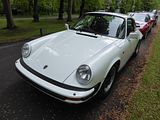
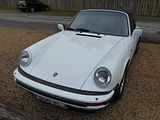
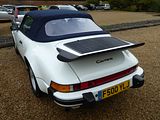
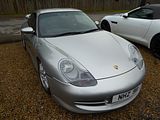
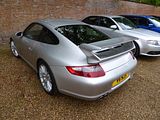
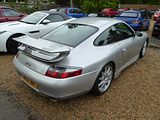


Looking very much like an early 911, this was in fact the 4 cylinder cheaper brother, the 912. Concerned that the considerable price increase of a Type 911 with “flat” six-cylinder powerplant over the Type 356 would cost the company sales and narrow brand appeal, in 1963 Porsche executives decided to introduce a new four-cylinder entry-level model. In 1963, Porsche assigned Dan Schwartz, later Chief Departmental Manager for Development, Mechanics, a project to oversee design and construction of a new horizontally-opposed four-cylinder engine for the car which was code-named 902, utilising components from the new 901 six-cylinder engine, that would produce higher performance than their 356SC engine, and be less costly and complex than their Carrera 2 engine. Another option explored by Claus von Rücker was to increase displacement of the 356 Type 616 engine to 1.8 litres, add Kugelfischer fuel injection, and modify both valve and cooling systems. Considering performance, cost, and scheduling, Porsche discontinued both of these design projects, and instead developed a third option, to tailor the 1.6 litre Type 616 engine to the 902. Before 911 production commenced in 1964, the Porsche Vehicle Research Department had set aside chassis numbers 13328, 13329, 13330, 13352, and 13386 through 13397 for research testing of the 902; research vehicle Serial Number 13394 is the oldest 902 known to exist today. In production form, the Type 912 combined a 911 chassis / bodyshell with the 1.6 litre four-cylinder, push-rod Type 616/36 engine, based upon the Type 616/16 engine used in the Type 356SC of 1964-1965. With a lower compression ratio and new Solex carburetors, the Type 616/36 engine produced five less horsepower than the 616/16, but delivered about the same maximum torque at 3,500 rpm versus 4,200 rpm for the 616/16. Compared to the 911, the resulting production Type 912 vehicle demonstrated superior weight distribution, handling, and range. To bring 912 pricing close to the 356, Porsche also deleted some features standard on the 911. As production of the 356 model concluded in 1965, on April 5, 1965 Porsche officially began production of the 912 coupé. Styling, performance, quality construction, reliability, and price made the 912 a very attractive buy to both new and old customers, and it substantially outsold the 911 during the first few years of production. Porsche produced nearly 30,000 912 coupé units and about 2500 912 Targa body style units (Porsche’s patented variation of a cabriolet) during a five-year manufacturing run. Production of the Targa, complete with removable roof and heavy transparent plastic rear windows openable with a zipper (later called ‘Version I’ by Porsche and the ‘soft-window Targa’ by enthusiasts), commenced in December 1966 as a 1967 model. In January 1968, Porsche also made available a Targa ‘Version II’ option (‘hard window Targa’) with fixed glass rear window, transforming the Targa into a coupé with removable roof. The Type 912 was also made in a special version for the German autobahn police (polizei); the 100,000th Porsche car was a 912 Targa for the police of Baden-Württemberg, the home state of Porsche. In the April 1967 edition, the Porsche factory’s Christophorus Magazine noted: “On 21 December 1966, Porsche celebrated a particularly proud anniversary. The 100,000th Porsche, a 912 Targa outfitted for the police, was delivered.” Porsche executives decided that after the 1969 model year, continuation of 912 production would not be viable, due to both internal and external factors. First, production facilities used for the 912 were reallocated to a new 914-6, a six-cylinder high performance version of the 914 Porsche-Volkswagen joint effort vehicle. Second, the 911 platform had returned to Porsche’s traditional three performance-level ladder, including a most powerful 911S, a fuel-injected 911E, and a base model 911T, with pricing largely in line with market expectations. Third, more stringent United States engine emission control regulations also had a bearing on the decision; Ferry Porsche stated “It would have taken some trouble to prepare the 912 for the new exhaust rules, and with the arrival of the 914 we would have had three different engines to keep current. That was too many.” Porsche had constructed more than 32,000 of the Type 912 from April 1965 to July 1969. For the 1970 model year the four-cylinder 914 superseded the 912 as Porsche’s entry-level model, which Porsche had thought would be less expensive for them to manufacture and sell than the 912. In practice, a deterioration in relationships between Porsche and Volkswagen – who had designed and planned to manufacture the 914 – severely curtailed the intended cost reduction, and 914 production was discontinued in early 1976. After a six-year absence, the 912 was re-introduced to North America as the 1976 model year 912E (internal factory designation 923) which shared the “G-Series” bodywork with the 911S. The “Prototyp” Museum collection in Hamburg, Germany includes a 912E pre-series vehicle constructed utilising a 911 Chassis No. 911 520 1617 and four-cylinder VW-Porsche 90HP 2.0 litre Type 4 similar to the late-model 2.0L 914/4. Once in production, the 912E was powered by an 86 bhp 2.0 litre Volkswagen air-cooled engine, refined with a new Bosch L-Jetronic fuel injection system. The 912E occupied the entry-level position left vacant by the discontinuation of the 914, while the new 924 – another Porsche-Volkswagen joint effort vehicle and the 914’s official replacement – was being finalised and put into production. During the production run of May 1975 to July 1976, Porsche manufactured nearly 2,100 of the 912E, targeted to the United States market.
More recent “entry level” Porsche models were this pair of Cayman models. As well as current GTS, there was a Cayman R here. The Cayman R made its world debut at the 2010 Los Angeles Auto Show on 17 November 2010. Based on the Cayman S, it featured the Porsche OEM aerokit that was first introduced in 2007 as a factory option, 19 inch lightweight wheels inherited from the Boxster Spyder, lighter aluminium doors from 997 911 GT3, lighter fibreglass bucket seats with carbon fibre backing from the 997 911 GT2, and with the removal of the radio, storage compartments, air-conditioning, and door handles which meant that the Cayman R weighed in at 54.8 kilograms (121 lb) less than a Cayman S. The Cayman R also received various cosmetic changes similar to ones seen on the earlier Cayman S Sport, such decals on the doors, instrument cover delete, gloss black painted mirrors, black model designation emblem on the trunk, as well as black painted wheels. With the new passive sports suspensions, the Cayman R was 10 mm (0.4 in) lower than a Cayman S equipped with PASM, or 20 mm (0.8 in) lower than one equipped with standard passive suspension. The engine was a 3.4-litre flat six Direct Fuel Injection DFI boxer engine that produced 330 hp. The standard Cayman R can achieve 0-60 mph in 4.7 seconds, and with the optional 7-speed PDK dual clutch transmission and the Sport Chrono package, it can achieve 0-60 mph in 4.4 seconds. The Cayman R with the manual transmission can reach the top speed of 175 mph and 174 mph with the PDK.
TVR
The Griffith was the first of the modern generation TVRs. First seen as a concept at the 1990 British Motor Show, it wowed the crowds sufficiently that unlike the Show Cars of precediing years, may of which were never seen again, Peter Wheeler and his small team in Blackpool immediately set about preparing it for production. It took until mid 1992 before they were ready. Like its forerunner namesakes, the Griffith 200 and Griffith 400, the modern Griffith was a lightweight (1048 kg) fibreglass-bodied, 2-door, 2-seat sports car with a V8 engine. Originally, it used a 4.0 litre 240 hp Rover V8 engine, but that could be optionally increased to a 4.3 litre 280 hp unit, with a further option of big-valve cylinder heads. In 1993, a TVR-developed 5.0 litre 340 hp version of the Rover V8 became available. All versions of the Griffith used the Lucas 14CUX engine management system and had a five-speed manual transmission. The car spawned a cheaper, and bigger-selling relative, the Chimaera, which was launched in 1993.
602 were sold in the first year and then around 250 cars a year were bought throughout the 90s, but demand started to wane, so iIn 2000, TVR announced that the Griffith production was going to end. A limited edition run of 100 Special Edition (SE) cars were built to mark the end of production. Although still very similar to the previous Griffith 500 model, the SE had a hybrid interior using the Chimaera dashboard and Cerbera seats. Noticeably, the rear lights were different along with different door mirrors, higher powered headlights and clear indicator lenses. Some also came with 16-inch wheels. Each car came with a numbered plaque in the glove box including the build number and a Special Edition Badge on its boot. All cars also had a unique signature in the boot under the carpet. The SEs were built between 2000 and 2002, with the last registered in 2003. A register of the last 100 SEs can be found at TVR Griffith 500 SE Register. These days, the Griffith remains a much loved classic and to celebrate the car, the owners have a meet called “The Griff Growl.”
VAUXHALL
It was nice to see an example of the VXR8 GTS, a Vauxhall badged version of the most potent Holden Commodore. With 576 bhp and 546 lb/ft of torque from the supercharged 6.2 litre engine, as well as launch control on the six speed manual box and plenty of grip from the 20″ tyres, this car can shoot to 60 mph in a super-car shaming 4.2 seconds, figures that closely match the Audi RS6, BMW M5 and E63 AMG but a much lower purchase price. Even so, the car has sold in small quantities in the UK.
VOLKSWAGEN
There were two performance Golf models which caught my eye. As well as the current and highly rated Golf R, there was a “big bumper” version of the second generation GTi here. These were the most obvious visual change, introduced in the summer of 1989 as part of a mid-cycle refresh of the Golf. VW had launched the second generation Golf in August of 1983, nearly 9 years after production of the first model to bear the name had begun. This time, a GTi version was included in the product plans from the start, and the new GTi was announced in May 1984. Like the regular Golf 2, it was almost 7″ longer than the Mark 1, with 3″ extra in the wheelbase and a 2″ wider track. It was also 10% heavier, but with significantly improved aerodynamics, resulting from attention to detail which included integrated gutters and flush glass as well as more rounded styling, the cd fell from 0.42 to 0.34. Initially it was powered by the same 1781cc fuel injected engine, but there were all round disc brakes and longer suspension travel improved the ride. Competitors came snapping at its heels, though, so after 2/5 years, VW responded by giving the car 24% more power, achieved by doubling the number of valves to 16. Lower stiffer suspension and bigger front brakes were also fitted, all of which restored the Golf GTi 16V to the top of the Hot Hatch pile. For most people that is, though the 8v car retained a following thanks to its broader torque spread. This less powerful car changed from a mechanical K-Jetronic injection system to a new Digifant electronic set up in 1987 at which point the front quarterlights were deleted, and a digital instrument pack became an option on the 16v car. Power steering became standard in late 1990 and the 8v gained the interior from the 16v model. Production ran through to February 1992, by which time the Mark 3 GTi was waiting in the wings. over 600,000 were built over an 8 year period, around 10% of all Mark 2 Golf production.
This proved to be a most enjoyable morning. It was well worth the early start, and now I know the format, even when I have a non theme-conpliant car, if the diary is clear, I will certainly try to fit another of these Wake Ups into the diary.


